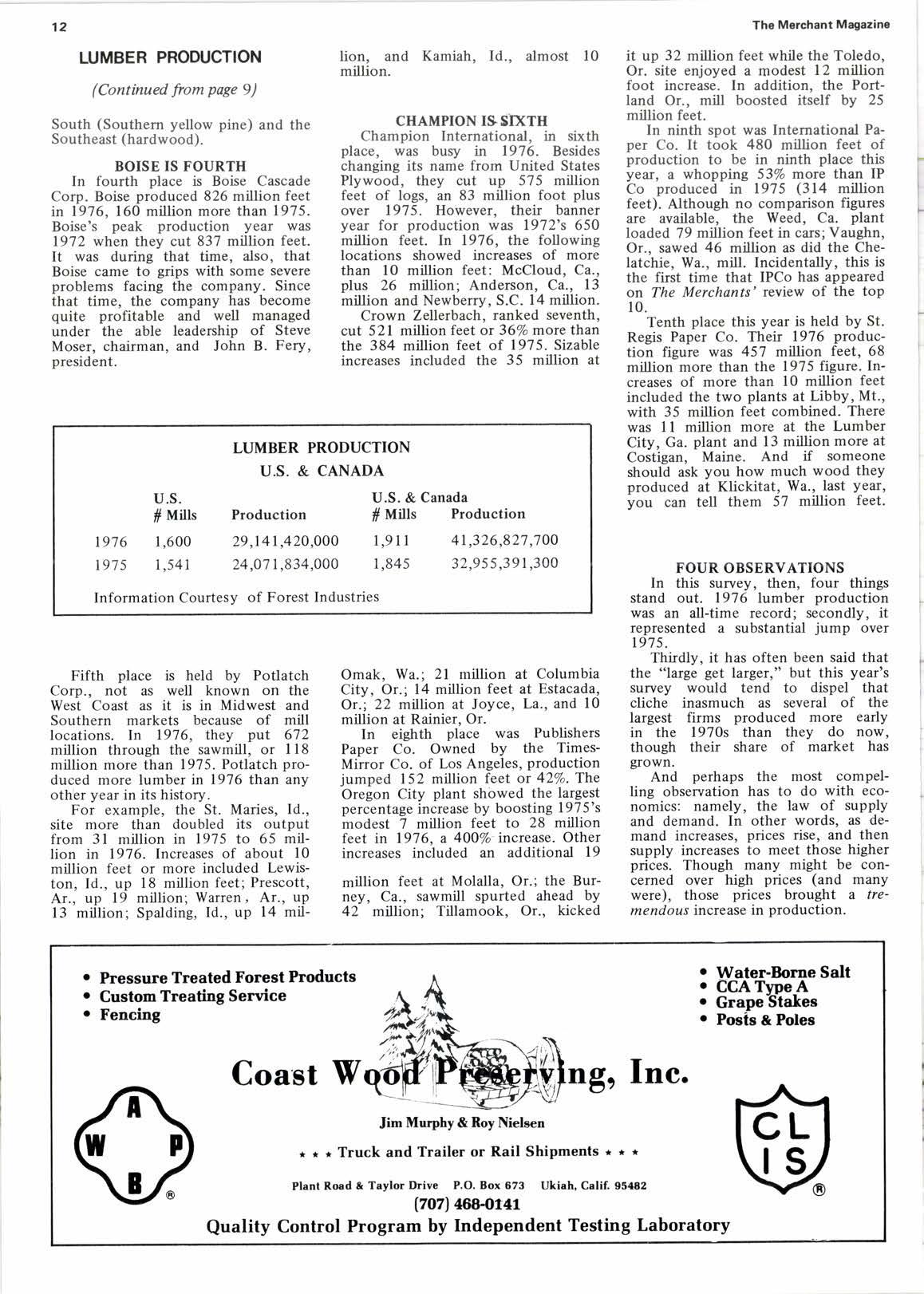
2 minute read
LUMBER PRODUCTION
(Continued from page 9)
South (Southern yellow pine) and the Southeast (hardwood).
Boise Is Fourth
In fourth place is Boise Cascade Corp. Boise produced 826 million feet in 1976, 160 million more than 1975. Boise's peak production year was 1972 when they cut 837 million feet. It was during that time, also, that Boise came to grips with some severe problems facing the company. Since that time, the company has become quite profitable and well managed under the able leadership of Steve Moser, chairman, and John B. Fery, president.
lion, and Kamiah, Id., almost l0 million.
Champion Iss Xth
Champion International, in sixth place, was busy in 1976. Besides changing its name from United States Plywood, they cut up 575 million feet of logs, an 83 million foot plus over 1975. However, their banner year for production was 1972's 650 million feet. In 1976, t}l.e following locations showed increases of more than l0 million feet: McCloud, Ca., plus 26 million; Anderson, Ca., 13 million and Newberry, S.C. 14 million.
Crown Zellerbach, ranked seventh, cut 521 million feet or 36Vo morc than the 384 million feet of 1975. Sizable increases included the 35 million at it up 32 millisn feet while the Toledo, Or. site enjoyed a modest 12 million foot increase. In addition, the Portland Or., mill boosted itself by 25 million feet.
In ninth spot was International Paper Co. It took 480 million feet of production to be in ninth place this yeat, a whopping 53% more than IP Co produced n 1975 (314 million feet). Although no comparison figures are available, the Weed, Ca. plant loaded 79 million feet in cars; Vaughn, Or.. sawed 46 million as did the Chelatchie, Wa., mill. Incidentally, this is the first time that IPCo has appeared on The Merchants'review of the top 10.
Tenth place this year is held by St. Regis Paper Co. Their 1976 production figure was 457 million feet, 68 million more than the 1975 figure. Increases of more than l0 million feet included the two plants at Libby, Mt., with 35 million feet combined. There was I I million more at the Lumber City, Ga. plant and l3 million more at Costigan, Maine. And if someone should ask you how much wood theY produced at Klickitat, Wa., last year, you can tell them 57 million feet.
Four Observations
In this survey, then, four things stand out. 1976 lumber production was an all-time record; secondly, it represented a substantial jump over t97 5.
Fifth place is held by Potlatch Corp., not as well known on the West Coast as it is in Midwest and Southern markets because of mill locations. In 1976, they put 6'12 million through the sawmill, or ll8 million more than 1975. Potlatch produced more lumber in 1976 than any oth'er year in its history.
For example, the St. Maries, Id., site more than doubled its output from 3l million in 1975 to 65 million in 1976. lncreases of about l0 million feet or more included Lewiston, Id., up l8 million feet; Prescott, Ar., up 19 million; Warren, Ar., up 13 million; Spalding, Id., up 14 mil-
Omak, Wa.; 2l million at Columbia City, Or.; 14 million feet at Estacada, Or.; 22 million at Joyce, La., and l0 million at Rainier, Or.
In eighth Place was Publishers Paper Co. Owned by the TimesMirror Co. of Los Angeles, production jumped 152 million feet or 42%.Tt.e Oregon City plant showed the largest percentage increase by boosting 1975's modest 7 million feet to 28 million feet in 1976. a 4OOVo'increase. Other increases included an additional l9 million feet at Molalla, Or.; the Burney, Ca., sawmill spurted ahead by 42 million; Tillamook, Or., kicked
Thirdly, it has often been said that the "large get larger," but this year's survey would tend to dispel that cliche inasmuch as several of the largest firms produced more early in the 1970s than they do now, though their share of market has grown.
And perhaps the most compelling observation has to do with economics: namely, the law of supply and demand. In other words, as demand increases, prices rise, and then supply increases to meet those higher prices. Though many might be concerned over high prices (and many were), those prices brought a tre' mendous increase in production.










